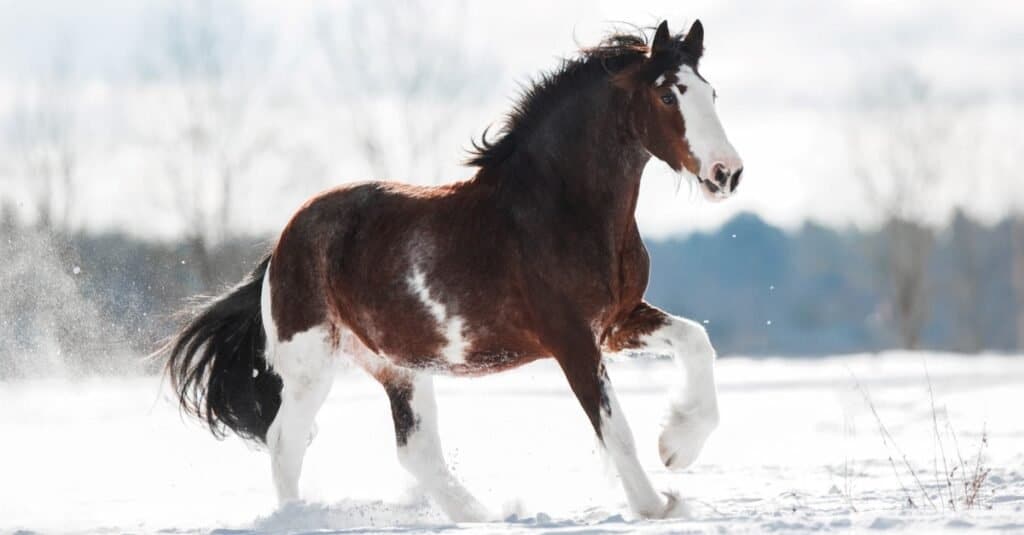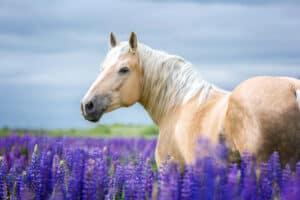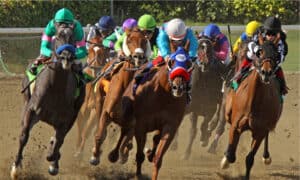Horses (Equus caballus) are amongst the most beautiful animals in the world, and are synonymous to speed, power and endurance. Cultures and civilizations have thrived because of horses being easy to domesticate. Horses have been used as means to transport people, build and carry heavy materials and structures, pull carts and carriages, and in agriculture. Now-a-days horses are kept for exercising and riding activities, games and horse racing purposes, many police departments and armies also have horse riding divisions.
In the United States, they’re an important part of the country’s history and culture.
Meet the Horse
Horses helped the U.S. become a developed country. In early days, people used horses for transportation, farm work, hunting, fighting in wars, and delivery services. Cowboys relied on their horses when herding cattle, traveling, or patrolling their territory. Horses have long been valued for their willingness to work with humans and the emotional bonds they share with us. Half work animal and half pet, the horse holds a unique position in North American culture.

There are nearly 8 million horses of various species in the United States.
©Horse Crazy/Shutterstock.com
Where do horses live?
Horses are plentiful in every state of the country. Some are farm horses, some are racehorses, and others are owned by people who love them as pets. Horses are highly adaptable and can live in a wide variety of environments.
What do horses eat?
Pasture grass and young plants are a horse’s favorite foods. These are also what horses in the wild primarily eat. Horses also eat hay, grains, oats, salts, and minerals.
What is their population in the United States?
There are about 7.7 million horses in the U.S.
There are about 459,526 horse farms that house a total population of 2,850,000 horses. While getting exact figures of wild animals can be difficult, getting exact counts of domestic animals is comparatively easy. For these numbers, we relied on horse organizations, including the American Horse Council, and other reliable sources. These numbers are for all breeds of horses.
Alabama: 114,300
Alaska: 9,100
Arizona: 142,000
California: 535,000
California may be known for Hollywood and the tech industry, but it has large patches of rural farmland, and horses are seen all over the state’s farms and ranches.
Colorado: 265,000
Horses are very popular in Colorado, which has a long history of ranching and rodeo riding. Horses have long been a favorite way to visit Colorado’s vast mountains and canyons.
Connecticut: 40,400
Delaware: 8,000
Delaware is a small state that is big on horses. With 8,000 of them, it is one of the most densely populated areas for horses in the country.
Florida: 387,000
Georgia: 133,000
Hawaii: 6,000
Hawaii has a unique ecosystem that differs from most of the continental U.S., but Hawaiians are as likely to enjoy horses as anyone else.
Idaho: 125,000
Illinois: 150,000
Indiana: 173,000
Iowa: 44,000
Kansas: 139,000
Kentucky: 238,000
Few states are as associated with horses and horse breeding as this one. Kentucky is home to the famous Kentucky Derby, which some people have called the “most exciting three minutes in sports.” Lexington is known as the horse capital of the world, and Shelbyville is considered the saddlebred horse capital of the world. Kentucky’s horse farms are famous for their beauty and the outstanding quality of horses they produce.
Louisiana: 120,500
Maine: 28,600
Maryland: 101,500
Like Kentucky, Maryland has a long association with horse racing and horse breeding. While the industry no longer holds a prominent place in the state’s economy, Maryland still has many scenic horse farms. The state hosts several major steeplechase and other horse-related events every year.
Massachusetts: 30,000
Michigan: 190,000
Minnesota: 146,000
Mississippi: 87,400
Missouri: 230,000
Montana: 104,900
Montana is ranch country, and ranchers still spend days on horseback with their cattle. Most people in the state use horses for pleasure riding, however, and horse breeding is a major part of the state’s economy. The state is home to the Montana Wild Horse Sanctuary.
Nebraska: 117,000
Nevada: 41,200
Nevada is home to some of the country’s most exotic scenery. Its vast deserts and rugged canyons are home to a huge variety of wild animals, including thousands of wild horses and wild burros. It also has many domesticated horses.

The Clydesdale
horse is one of the tallest
horses.
©OlesyaNickolaeva/Shutterstock.com
New Hampshire: 11,700
New Jersey: 59,400
New Mexico: 113,500
New York: 154,000
North Carolina: 205,200
North Carolina’s Outer Banks are home to several herds of wild horses.
North Dakota: 47,000
Ohio: 256,000
Oklahoma: 253,000
Oregon: 135,200
Pennsylvania: 223,600
Rhode Island: 2,600
South Carolina: 73,600
South Dakota: 96,500
Tennessee: 165,800
Texas: 767,000
Texas has a reputation as cowboy country, and that is borne out by its large number of horses. Texas hosts thousands of horse-related events each year, including rodeos, horse and cattle shows, and more.
Utah: 96,400
Vermont: 19,800
Vermont’s state animal is the Morgan horse, which was bred in Vermont.
Virginia: 183,600
Virginia has a long association with hunt club racing, and it is home to many stunning horse farms. Virginia’s small town of Middleburg is nicknamed “horse country” because it hosts dozens of important races. Many of the proceeds from these races go to various charities.
Washington: 197,200
West Virginia: 69,800
Wisconsin: 150,300
Wyoming: 78,600
Next Up…
- Most Expensive Horses in The World: Horses are very expensive and need a lot of upkeep. Exactly how much does it cost to buy a horse? Find out here.
- 10 of the Smartest Horses: Horses are intelligent animals with lot of empathy. Find out here about the 10 very smart horse and what they have done to be recognized as such.
- Zebra vs Horse: What Are the Differences?: Are Zebras related to horses? Read what experts have to say.
The photo featured at the top of this post is © Anaite/Shutterstock.com
Sources
- Horsey Hooves, Available here: https://horseyhooves.com/wild-horses-in-america/
- Horse Council, Available here: https://www.horsecouncil.org/press-releases/us-horse-population-statistics/
FAQs (Frequently Asked Questions)
Which states have the most horses?
- California: 535,000
- Florida: 387,100
- Kentucky: 238,000
- Ohio: 256,000
- Oklahoma: 253,00
- Texas: 767,000
What Is the Population of Wild Horses in the United States?
Wild horses live on the open range. Free from corrals or stables, these untamed equines form large herds that travel together. A horse herd is usually headed by an older mare, who controls the herd and decides where it is going. The males are there to protect the herd and mate with the other mares.
The leader of the herd is a mare, usually the oldest. She may be weaker than the males and other mares, but she still dominates the herd.
There are around 90,000 wild horses in the U.S. Roughly half of them live in Nevada, which is home to the famed Virginia Range herd. There are several places to see wild horses:
- Theodore Roosevelt National Park, North Dakota
- Tonto National Forest in Arizona
- Dugway, Utah, home of the Unaqui herd
- Pryor Mountains in Montana and Wyoming
- Outer Banks, North Carolina
- Assateague Island, Maryland
- Chincoteague Island, Virginia
- Sand Wash Basin, Colorado
- Cumberland Island, Georgia
- Steens Mountain Wilderness Area, Oregon, home of the Kiger Mustang herd
Thank you for reading! Have some feedback for us? Contact the AZ Animals editorial team.






